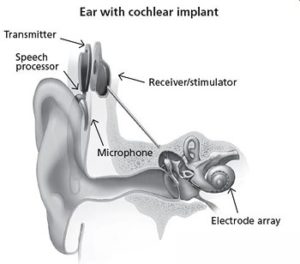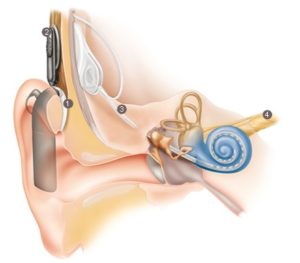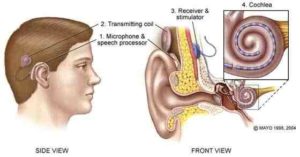What is Cochlear Implant?
A cochlear implant is an electronic device that restores hearing for people anywhere from hard of hearing to the profoundly deaf. The cochlear implant is surgically implanted under the skin behind the ear. The surgeon puts the electrode array inside the inner ear and then inside the cochlea. The implant works by a device outside the ear, which rests on the skin behind the ear. It is held upright by a magnet and is also connected by a lead to a sound professor.
If you’re very hard of hearing or deaf, a cochlear implant may help you get back the sounds you miss.
It isn’t a hearing aid, which makes sounds louder. It’s a small device that a doctor puts in your ear through surgery. It sends impulses directly to your auditory nerve, which carries sound signals to your brain.
The implant doesn’t make you hear normally again, but it can help you with sounds. Most people with severe to profound hearing loss can understand speech in person or over the phone better than they did with a hearing aid. It can usually help you know sounds around you, including telephones, doorbells, and alarms. Many people also can pick up on speech in noisy places better than they did with hearing aids, or even enjoy music again.
Who should get a cochlear implant?
The American Speech-Language-Hearing Association says the device is best for adults who have:
- Severe to profound hearing loss in both ears

- Hearing loss after they’ve already learned speech and language
- Limited help from hearing aids
- No medical problems that would make surgery risky
- A strong desire to hear better
- A good understanding of what the device will — and won’t — do for them
Also, cochlear implants work better for people who have lost their hearing recently, as well as those who’ve already used a hearing aid successfully.
What happens when you get a cochlear implant?
First, you are given an injection to make you fall asleep. Once you’re asleep the hair behind your ear is shaved off. Then you have the operation that usually lasts from 2-4 hours. The doctor cuts behind your ear and puts the implant into the bone right there. Next he places an electrical array the curls inside your cochlea. When you wake up you are sent home for a few days to rest. After you are all rested you go to an audiologist to get the sound professor programmed. The sound professor is a main part is allowing you to hear when you have a cochlear implant and when it’s not in, you won’t hear anything. Once the sound professor is programmed you with be able to hear.
The cochlear implant uses a much different method to enable a person to hear opposed to a normal hearing ear. The cochlear implant has five parts; a microphone, sound processor, head piece, implant and hearing nerve. The microphones function is to capture sound from the outside environment. A sound processor than selects and arranges all the sounds captured from the microphone. The headpiece sends the signal through the skin and to the implant to pick up. Than the implant picks up the sound and sends it through the lead and to the electrode array. Finally, the sound is picked up by the hearing nerve and the message is sent to the brain.
Who can they help?
The cochlear implant technology can help people who:
- have moderate to profound hearing loss in both ears
- receive little or no benefit from hearing aids
- score 50% or less on sentence recognition tests done by hearing professionals in the ear to be implanted
- Score 60% or less on sentence recognition tests done by hearing professionals in the non-implanted ear or in both ears with hearing aids.
Many people have cochlear devices in both ears (bilateral). Listening with two ears can improve your ability to identify the direction of sound and separate the sounds you want to hear from those you don’t.
What happens before surgery?
Primary care doctors usually refer patients to ear, nose and throat doctors (ENT doctors or otolaryngologists) to test them to see if they are candidates for cochlear implants.
Tests often done are:
- examination of external, middle, and inner ear for signs of infection or abnormality
- various tests of hearing, such as an audiogram
- a trial of hearing aid use to assess its potential benefit
- exams to evaluate middle and inner ear structures
- CT (computerized tomography) scans. This type of x-ray helps the doctor see if the cochlea has a normal shape. This scan is especially important if the patient has a history of meningitis because it helps see if there is new bone growth in the cochlea that could interfere with the insertion of the implant. This scan also may indicate which ear should be implanted.
- MRI (magnetic resonance imaging) scan
- psychological examination to see if the patient can cope with the implant
- Physical exam to prepare for general anaesthesia.
What happens during surgery?
The doctor or other hospital staff may:
- insert some intravenous (i.v.) lines
- shave or clean the scalp around the site of the implant
- attach cables, monitors and patches to the patient’s skin to monitor vital signs
- put a mask on the patient’s face to provide oxygen and anesthetic gas
- Administer drugs through the I’ve. and the face mask to cause sleep and general anaesthesia
- Awaken the patient in the operating room and take him or her to a recovery room until all the anaesthesia is gone.
What happens after surgery?
Immediately after waking, a patient may feel:
- pressure or discomfort over his (or her) implanted ear
- dizziness
- sick to the stomach (have nausea)
- disoriented or confused for a while
- a sore throat for a while from the breathing tube used during general anaesthesia
Then, a patient can expect to:
- keep the bandages on for a while

- have the bandages be stained with some blood or fluid
- go home in about a day after surgery
- have stitches for a while
- get instructions about caring for the stitches, washing the head, showering, and general care and diet
- have an appointment in about a week to the stitches removed and have the implant site examined
- have the implant “turned on” (activated) about 3-6 weeks later
What are the Benefits of Cochlear Implants?
For people with implants:
- Hearing ranges from near normal ability to understand speech to no hearing benefit at all.
- Adults often benefit immediatelyand continue to improve for about 3 months after the initial tuning sessions. Then, although performance continues to improve, improvements are slower. Cochlear implant users’ performances may continue to improve for several years.
- Children may improve at a slower pace.A lot of training is needed after implantation to help the child use the new ‘hearing’ he or she now experiences.
- Most perceive loud, medium and soft sounds.People report that they can perceive different types of sounds, such as footsteps, slamming of doors, sounds of engines, ringing of the telephone, barking of dogs, whistling of the tea kettle, rustling of leaves, the sound of a light switch being switched on and off, and so on.
- Many understand speech without lip-reading.However, even if this is not possible, using the implant helps lip-reading.
- Many can make telephone callsand understand familiar voices over the telephone. Some good performers can make normal telephone calls and even understand an unfamiliar speaker. However, not all people who have implants are able to use the phone.
- Many can watch TV more easily,especially when they can also see the speaker’s face. However, listening to the radio is often more difficult as there are no visual cues available.
- Some can enjoy music.Some enjoy the sound of certain instruments (piano or guitar, for example) and certain voices. Others do not hear well enough to enjoy music.
What are the advantages of a cochlear implant?
It can be life-changing if you have a serious hearing problem. But the results aren’t the same for everyone. Some people benefit more than others. Some of the pros:
- You may be able to hear speech at a nearly normal level.
- You may be able to understand speech without lip reading.
- It’s easier to talk on the phone and hear the TV.
- You may be able to hear music better than before.
- You can pick up on different types of sounds, including soft, medium, and loud ones.
- You can better control your own voice so that it’s easier for others to understand you.
What are the disadvantages and risks?
Cochlear implant surgery is very safe, but any operation comes with risks. Problems can include bleeding, infections, and side effects from the medicine that sends you to sleep during the procedure.
Other possible complications include:
- A nerve injury that changes your sense of taste
- Nerve damage that causes weakness or paralysis in your face
- Dizziness or balance problems
- Loss of the hearing you have left
- Ringing in your ears, called tinnitus

- Leaks of the fluid around the brain
- The device doesn’t work or gets infected, which may mean you’ll have to remove and replace the implant.
- Meningitis, an infection of the membranes around the brain. It’s a rare but serious complication. Children and people with abnormally formed inner ears seem to be at higher risk. The FDA and CDC recommend vaccines for anyone who gets a cochlear implant to lower their risk for the disease.
Things to do after surgery
For a short period of time after the surgery, a special bandage is worn on the head during sleep. After about one month, the surgical wounds are healed and the patient returns to the implant clinic to be fitted with the external parts of the device and to have the device turned on and mapped. Mapping involves fine tuning the speech processor and setting levels of stimulation for each electrode, from soft to loud.
The patient is then trained in how to interpret the sounds heard through the device. The length of the training varies from days to years, depending on how well the person can interpret the sounds heard through the device.
Can an Implant Restore Hearing for Everyone?
Cochlear implants are very successful for some people, but not everyone is a candidate to receive one. Children 12 months of age or older with profound hearing loss in both ears are usually excellent candidates, but not every child is eligible.
Common reasons that a child might not be eligible for a cochlear implant include:
- the child’s hearing is “too good” (meaning the child can hear some sound and speech with hearing aids)
- the hearing loss isn’t due to a problem with the cochlea
- the child has had profound deafness for a long time
- the auditory nerve itself is damaged or absent
Each potential candidate must be evaluated by a cochlear implant team to see whether a cochlear implant is the best option.
Benefits of an implant can vary. The rehabilitation period can be long, and many factors (such as the condition of the auditory nerve or the presence of scar tissue in the cochlea) can affect the success of the implant.
The doctor or surgeon will help parents understand what an implant can reasonably achieve for their child.
